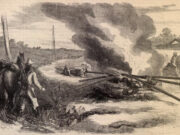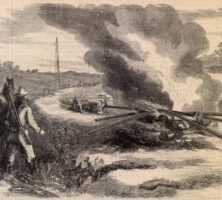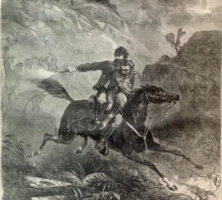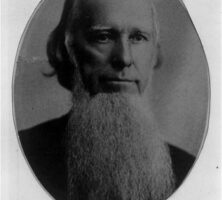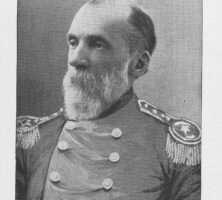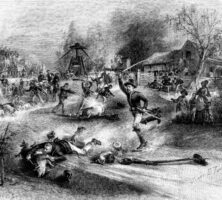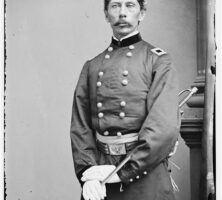Guerrilla warfare in Georgia during the Civil War (1861-65) often took place in sparsely populated regions where Unionist or anti-Confederate sentiment created divisions among the civilian population. In many cases Unionist and Confederate neighbors clashed for control of their communities. In other instances guerrillas operated against major field armies. Confederate guerrilla activities affected the policies of Union general William T. Sherman, pushing him to adopt harsh retaliatory measures to protect his railroad supply lines as he moved through Georgia in 1864. In the final stages of the Civil War, guerrilla activities became an acute problem for areas in which civil authority had broken down. Irregular bands terrorized and plundered farms and towns, killing or wounding large numbers of people.

From Harper's Weekly
According to historian Daniel Sutherland, Civil War guerrillas, regardless of what they called themselves or the side for which they fought, shared at least two characteristics. First, guerrillas utilized unconventional methods of warfare to harass and worry their foes, tactics that stood in marked contrast to those of conventional armies. Second, guerrillas saw their principal responsibility as defending their homes and communities from internal or external foes.
Guerrilla Activity in North Georgia
One of the earliest catalysts for guerrilla activity in Georgia was the Conscription Act, which was passed by the Confederate Congress in April 1862. Those men wishing to avoid the draft often formed armed bands, which were sometimes joined by Confederate army deserters. Such groups were particularly active in parts of north Georgia, where staunch Unionists and dissenting civilians who were disenchanted with Confederate government policies comprised a minority of the population. In July 1862, for example, a citizen in Gilmer County noted that a contingent of well-armed and mounted men, roaming the countryside to avoid conscription, were stealing, burning houses, killing livestock, and threatening the wives of Confederate soldiers.
In 1863 Georgia governor Joseph E. Brown responded to such complaints by dispatching parties of state and Confederate soldiers into mountain counties to track down and arrest dozens of disloyal civilians. These same counties also responded to local disturbances by forming safety committees and home guard companies to protect them from “tories,” or Unionists. Unionist guerrillas had their own support networks of civilians, particularly in such northern counties as Fannin, where anti-Confederate feelings were widespread.
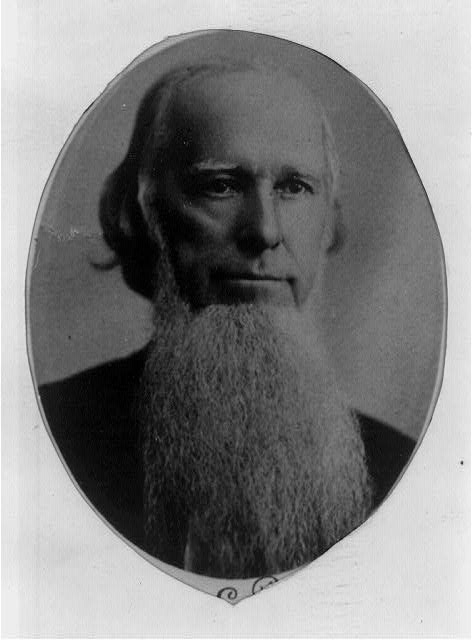
Courtesy of Library of Congress, Prints and Photographs Division
In an effort to control guerrilla organizations and maintain order in north Georgia, Governor Brown granted commissions authorizing mounted commands to the region. Brown also attempted to address the problem of lawless bands of men stealing property from civilians around the state. The governor was careful not to accuse any of the bands raised under his authority with these crimes, noting that the lawless men often misidentified themselves as Confederate cavalrymen under General Joseph Wheeler.
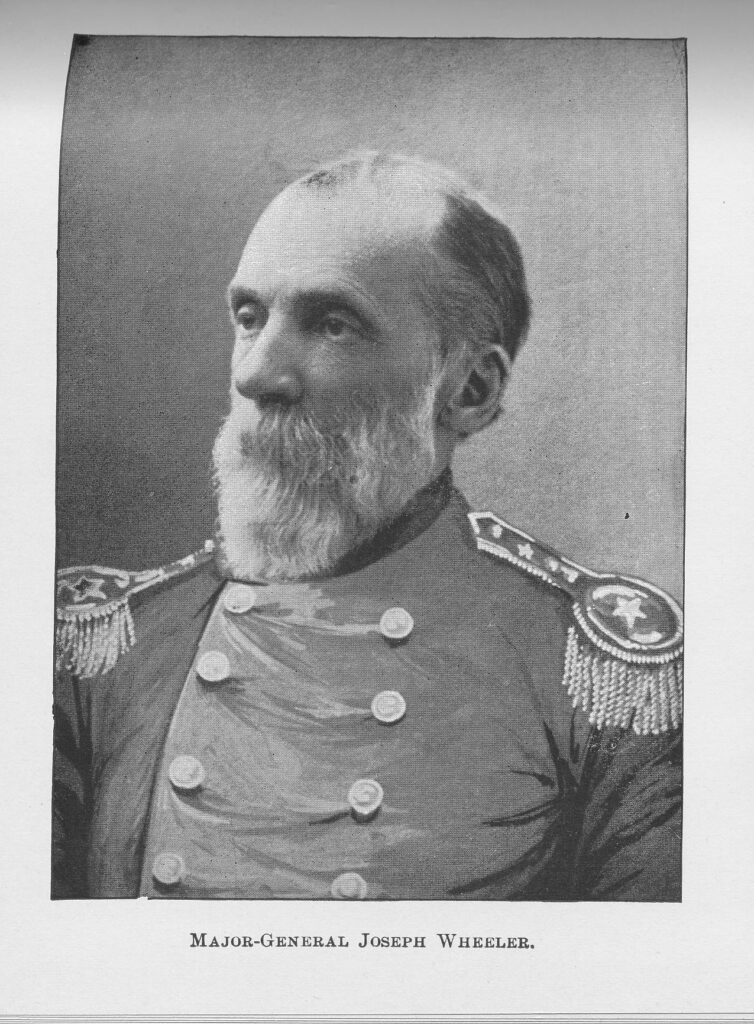
From The Conflict with Spain and Conquest of the Philippines, by H. F. Keenan
John P. Gatewood and his murderous gang comprised probably the best-known guerrilla force operating in north Georgia. Gatewood never received official state sanction, but he might have operated periodically under Wheeler’s authority. Although most of Gatewood’s numerous victims were U.S. soldiers or Unionist civilians, his men sometimes brutalized even Confederate sympathizers.
Guerrilla Activity in South Georgia
The southern part of the state was also periodically plagued with guerrilla violence, and the swamps and pine barrens of south Georgia provided hiding places for deserters, draft evaders, and Unionists. In November 1863 an expedition involving state and Confederate troops passed through Wilcox, Ware, Coffee, and Clinch counties, arresting deserters and fugitives from slavery along the way. The Okefenokee Swamp was another refuge for individuals and small groups of men, although the number of draft evaders or deserters who hid there is impossible to determine.
Citizens in Worth County reported in October 1864 that lawless villains prowled over the county, stealing and committing depredations. Bands of deserters raided the town of Blackshear, in Pierce County, ransacking local stores seven times in February 1865. A Confederate inspector in Ware County reported that men seeking to evade conscription had banded together south of the Altamaha River to resist arrest.
Sherman’s Response to Guerrillas
As Sherman’s troops advanced into northwest Georgia during the 1864 Atlanta campaign, they encountered Confederate guerrillas intent on disrupting the Western and Atlantic Railroad, the Union’s main supply line. Sherman declared that such activity was criminal and that guerrillas behaved like animals in their flouting of the conventions of war. Union general James B. Steedman, given responsibility for protecting the Western and Atlantic in late June 1864, attempted to fulfill his duty by issuing orders that any citizens found within three miles of the railroad be arrested and tried as spies. Despite such measures, Confederate partisans and guerrillas continually cut telegraph lines and partially disabled the railroad, although Union repair crews usually restored the lines in a timely fashion.
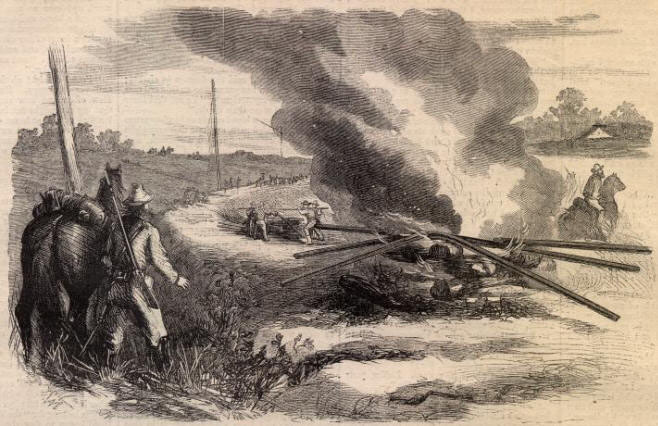
From Harper's Weekly
During the Atlanta campaign and the subsequent March to the Sea, Sherman employed a policy of punishing civilians for guerrilla activity. If guerrillas or bushwhackers struck at Union forces or attempted to impede their march by destroying bridges and obstructing roads, Sherman often ordered the destruction of houses in the vicinity. Some of the harshest reprisals for the attacks of guerrillas and Confederate cavalry scouts took place in the fall of 1864, when Union troops burned much of the town of Cassville, in Bartow County, and portions of other towns in northwest Georgia.
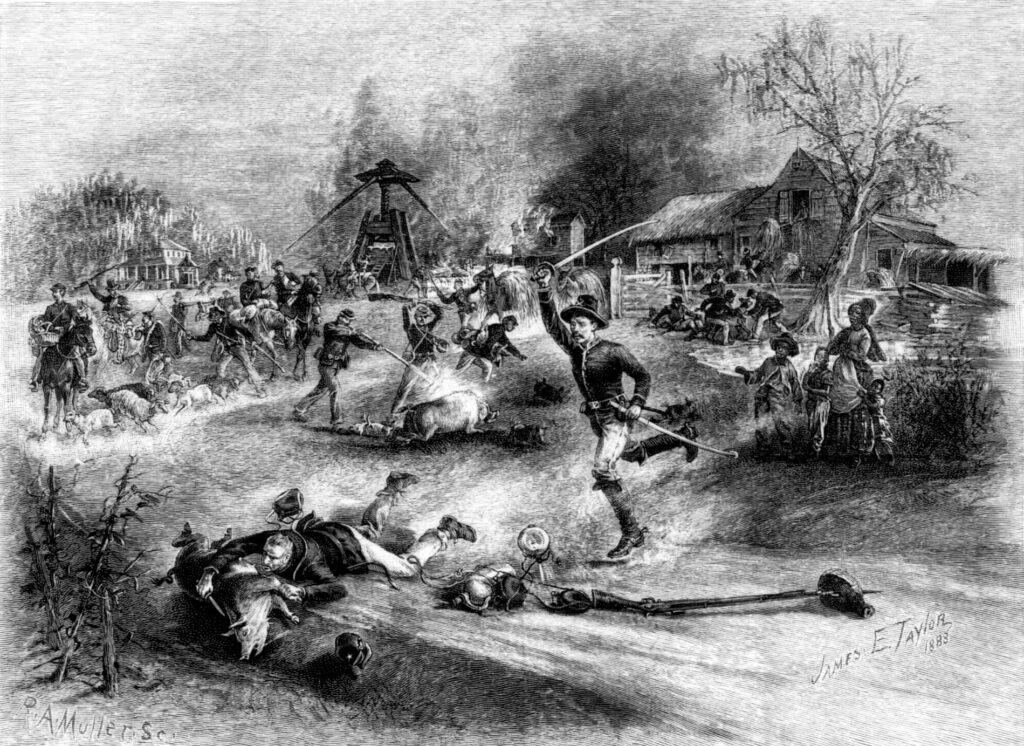
From Battles and Leaders of the Civil War, vol 4., edited by R. U. Johnson and C. C. Clough Buel
Surrender and Paroles
By the final months of the war, local legal systems no longer functioned in many parts of Georgia, and guerrilla activity increased accordingly. Large numbers of Confederate army deserters in the Georgia mountains joined home guard, militia, or irregular organizations. Many of these deserters claimed that they had taken furloughs to protect their home communities from bushwhackers or robbers.
The presence of guerrilla and state-sanctioned irregular military organizations in north Georgia generated a passionate public debate over their activities and composition. Some citizens characterized these bands as fearless protectors of Southern citizens, while others claimed that the groups sheltered deserters and even men who had formerly served in Union home guard companies. A civilian writing to an Augusta newspaper in January 1865 noted that lawless parties were too large to capture and predicted that anarchy would result in north Georgia if the war did not end soon.
In early February 1865 Confederate general W. T. Wofford arrived in north Georgia, raising the hopes of civilians that law and order might be restored in their region. Wofford estimated that between 3,000 and 5,000 men in north Georgia belonged in the Confederate army, and he claimed that they would soon be organized not only to resist enemy raids but also to assume the offensive. Wofford’s subsequent actions suggest that his primary goal was to restore law and order in his native region.
Wofford surrendered all Confederate forces in north Georgia at Kingston, in Bartow County, on May 12, 1865. In the preceding weeks, Wofford had attempted to meet with roughly 500 guerrillas who had refused to obey his orders to surrender. Union general Henry M. Judah, who had negotiated with Wofford, announced that anyone who did not surrender would be considered an outlaw. Judah believed that his ultimatum resulted in the capitulation of most guerrillas in north Georgia. The decision made in May 1865 by thousands of home guard soldiers to travel to Kingston to surrender and receive parole suggests some degree of continued affiliation with the Confederate army.
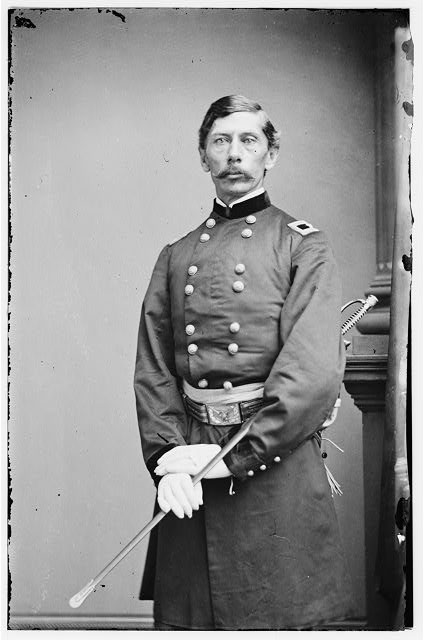
Courtesy of Library of Congress, Prints and Photographs Division
Guerrillas knew that their paroles would protect them from punishment at the hands of military authorities but not from local civil prosecution, leading Wofford to predict that most irregulars would move abroad. It is impossible to determine how many guerrillas actually migrated, but the notorious Gatewood and his gang were among those who departed the state, heading for Texas.


